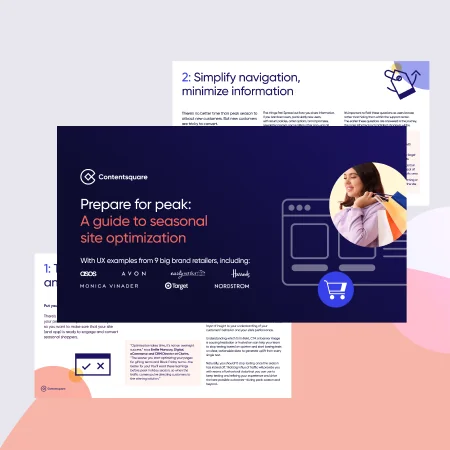
How to prepare for peak sale season
A guide to seasonal site optimization with UX examples from 9 big brand retailers.

The clue’s in the name: Peak seasons are always a big deal for eCommerce brands. Whether it’s Christmas, Halloween, Valentine’s Day, Mother’s Day, Father’s Day or Cyber Week, the holiday season is invariably the busiest time of year for retailers.
However, it’s never been as critical as it is now to take advantage of seasonal surges.
Over half (57%) of retail sites saw less traffic YoY in 2023, according to our 2024 Retail Digital Experience Benchmark Report. At the same time, ad spend rose. This pushed cost per visit up by +12.4%.
This means it costs more than ever to attract visitors to your site. And to make matters worse, the visitors you manage to attract will also have less money to spend on online shopping.
According to Bazaarvoice’s Shopper Experience Index (SEI) 17, 73% of consumers have changed their spending habits due to the cost of living crisis, with 77% choosing to spend less on non-essential products.
But it’s not all doom and gloom for online retailers.
With cash-strapped shoppers looking to find the best bang for their buck in 2024, brands have plenty of scope to attract and retain new customers right now. Indeed, Bazaarvoice’s Shopper Experience Index reports that 70% of shoppers are currently willing to switch brands
And peak season, when shoppers are primed to look for the best deals on offer and eCommerce sales figures tend to spike, is the perfect time to capitalize on this opportunity.
To get a handle on just how big the peak opportunity is, let’s look at some eCommerce peak season stats from Contentsquare’s 2024 Retail Peak Season Benchmarks, an analysis of website performance over 2023’s Black Friday period.
The pressure is on to make the most of the next eCommerce peak season—and we can help you take some of that pressure off.
In this in-depth article, we run through some tips for preparing your website (and app) for peak season success.
And there’s more where that came from.
To learn more strategies for getting your website ready for peak (complete with examples of big eCommerce brands optimizing their digital experiences to drive better outcomes, both in and out of peak season) download our handy how-to guide.

How to prepare for peak sale season
A guide to seasonal site optimization with UX examples from 9 big brand retailers.
In the dynamic realm of eCommerce, preparation is the key to thriving during peak shopping seasons like Black Friday, Cyber Monday, Valentine’s, Halloween and Christmas.
Digital leaders know that planning thoroughly in advance is essential for not only surviving but excelling during these periods of heightened online activity and customer demand.
But how can you make sure that your eCommerce business’s site is ready for the peak season?
It’s a three-step process…
The first and arguably most pivotal step is to evaluate and optimize your existing digital channels well in advance of the peak season frenzy.
Of course, what the ‘best customer experience’ looks like depends on the sort of customer you’re serving. With that in mind, it helps to understand what the typical peak visitor will look like.
While this naturally differs for every business, you can get a general idea of what to expect by checking out our 2024 Peak Season Benchmark data.
This tells you (among other things) that last year’s peak visitors:
One traffic trend to be aware of (a trend covered extensively in Bazaarvoice’s Shopper Experience Index report) is the growing importance of social media.
Bazaarvoice reports that over half (58%) of shoppers say they often discover a product or service through social media—and among 18-34 year olds, 73% have bought products via social media in the last year.
Whoever your visitors are, and however they arrive on your sites, your goal when preparing for peak is to ensure that your digital experience (and therefore their holiday shopping experience) is as engaging and frustration-free as possible.
Visitor frustration is a big problem in the digital experience domain, and our 2024 Peak Digital Experience Benchmark data shows that 2 in 5 (40.2%) of sessions were marred by some form of it over the course of 2023’s Black Friday season.
By drawing insights from prior experiences and harnessing data from an Experience Intelligence platform with Digital Experience Analytics (DXA), Digital Experience Monitoring (DEM), Voice of Customer and Product Analytics capabilities, you can make informed decisions to reduce frustration and maximize engagement.
A great Experience Intelligence Platform will enable you to:
Want to learn more about Digital Experience Analytics and Digital Experience Monitoring? Watch our short explainer videos below.
For eCommerce brands, it’s become increasingly important to provide site visitors and app users with the social proof that comes with User Generated Content (UGC).
Customers trust other customers more than they trust brands. Bazaarvoice’s Shopper Experience Index survey found that 78% of customers feel more confident in making a purchase when they can see UGC on the product page—and 55% say they’re unlikely to make a purchase without it.
And with the cost of living crisis making every purchase decision a little (or a lot) weightier, and customers looking for endorsements to give them confidence, UGC is becoming ever more pivotal: 35% of customers globally (and 43% of US customers) rely on UGC more in the current climate, according to Bazaarvoice.
Featuring UGC on your product pages is one proven strategy to drive better outcomes during peak season—but it’s far from the only one.
Don’t forget to check out our guide to seasonal site optimization for more tips on driving conversions through smarter site and app design.

How to prepare for peak sale season
A guide to seasonal site optimization with UX examples from 9 big brand retailers.
On-site optimizations can do a lot for you, but not everything happens in-site.
As you read this, you’re probably running at least one advertising campaign (and maybe even several at once) that’s driving traffic to your site and consuming your budget.
It wouldn’t be wise to lose sight of how all that inbound traffic arrives on your site, or to forget to ensure that, wherever they come from, their journey is as smoothly integrated as possible.
Establishing seamless connections across your digital ecosystem is imperative. If you’re to perform at your best during eCommerce peak season, you won’t have time to consolidate data and information across different platforms.
So make sure you integrate your Google or Adobe Analytics campaigns with your Experience Intelligence platform to create a comprehensive monitoring framework in advance.
This integration equips you with the ability to track and comprehend the performance of your marketing campaigns, thereby enabling the development of a digital experience that optimally directs traffic and enhances conversion rates.
Beyond marketing campaigns, as a general rule, integrate as much customer information as you can. VoC, APM solutions, Web Analytics, A/B Testing… all of them could work together and enhance and supercharge your marketing tech stack.
To get an even more comprehensive understanding of your visitors and what makes them engage, return and convert, you should use Product Analytics to track and analyze user journeys across multiple sessions spanning your website, app and other branded experiences.
Obtaining this knowledge is crucial not only for your ability to respond in the short-term, but also for future analysis and to lead you to better and more efficient campaigns.
Customer data flows incessantly during peak seasons—and you can’t rely on manual methods to make sense of it. It’ll be too time-consuming and slow.
Instead, you should embrace automation as your ally in efficiently managing the inundation of data. Implementing integrations that automate routine tasks and decisions will enable seamless operation when the crucial moment arrives.
The capacity to analyze data in real-time is equally indispensable.
Leveraging machine learning and AI-driven insights empower you to make instantaneous, data-supported decisions, identify trends, make predictions regarding customer behavior and mount proactive responses.
Such real-time adaptability can determine whether you capitalize on surges in demand or miss out on valuable opportunities.
Contentsquare’s Experience Intelligence platform empowers businesses with various real-time analytic capabilities, including:
Our Experience Intelligence platform provides thousands of retailers and eCommerce brands with insight into shoppers’ behaviors, feelings and intent, helping them to build more effective customer experiences on their websites and apps.
For eCommerce brands looking to make their next eCommerce peak season pop, one of our key integration partners is Bazaarvoice, a full funnel user generated content (UGC) platform for eCommerce brands.
As we mentioned earlier, UGC is hugely important for driving conversions—particularly during peak season, when shoppers are bombarded with rival promotional offers and are looking for reasons to buy from your brand.
By integrating Contentsquare with Bazaarvoice, you can get a better understanding of the impact that user UGC, ratings, and reviews are having on your engagement metrics, conversion rates, and online revenue.
You can read more about how this integration enhances both Contentsquare and Bazaarvoice here.
Want to see exactly what Contentsquare can do for your brand as we approach peak season? Book a demo: We can’t wait to show you.

Take a product tour
Get to grips with Contentsquare fundamentals with this 6 minute product tour.